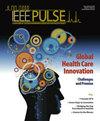使用微型和纳米机器人增强治疗递送。
IF 0.3
4区 医学
Q4 ENGINEERING, BIOMEDICAL
引用次数: 0
摘要
“传统的给药方式效率很低。例如,据报道,对于实体瘤,给药效率低于1%[1]这意味着99%的药物是在身体的其他地方引起副作用,而不是真正对抗癌症。这就是微型和纳米机器人可以发挥作用的地方,因为它们可以以可控的方式游泳或移动到目标位置。这就是希望。”——田秋,博士,生物医学机器人开发人员。本文章由计算机程序翻译,如有差异,请以英文原文为准。
Enhancing Therapeutic Delivery Using Micro- and Nanorobots.
"The traditional way of delivering drugs has a very low efficiency. For instance, with solid tumors, drug delivery efficiency is reported to be lower than 1% [1], which means that 99% of the drug is elsewhere in the body causing side effects instead of actually fighting the cancer. This is where micro- and nanorobots can come into play, because they can swim or otherwise move to the target location in a controllable way. This is the hope."-Tian Qiu, Ph.D., biomedical robotics developer.
求助全文
通过发布文献求助,成功后即可免费获取论文全文。
去求助
来源期刊

IEEE Pulse
ENGINEERING, BIOMEDICAL-
CiteScore
1.10
自引率
0.00%
发文量
88
审稿时长
6-12 weeks
期刊介绍:
IEEE Pulse covers both general and technical articles on current technologies and methods used in biomedical and clinical engineering; societal implications of medical technologies; current news items; book reviews; patent descriptions; and correspondence. Special interest departments, students, law, clinical engineering, ethics, new products, society news, historical features and government.
 求助内容:
求助内容: 应助结果提醒方式:
应助结果提醒方式:


